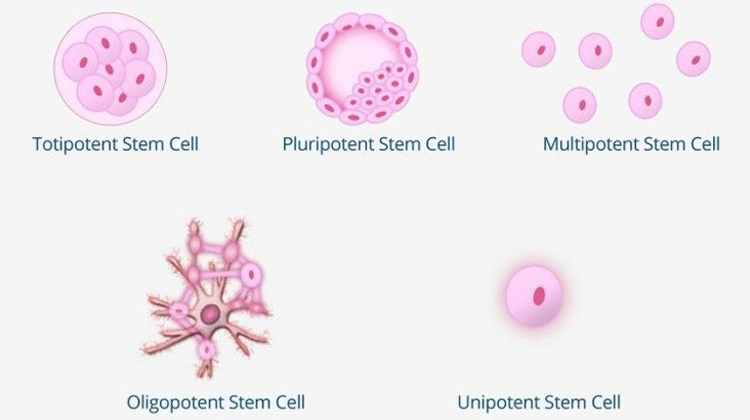*Post also available in:
As you start to learn about stem cells, one of the most common questions to have is, “What types of stem cells exist?” There is not an agreed-upon number of stem cell types, because one can classify stem cells either by differentiation potential (what they can turn into) or by origin (from where they are sourced).
This post is dedicated to explaining the five types of stem cells, based on differentiation potential.
5 Types of Stem Cells by Differentiation Potential
The five different types of stem cells discussed in this article are:
- Totipotent (or Omnipotent) Stem Cells
- Pluripotent Stem Cells
- Multipotent Stem Cells
- Oligopotent Stem Cells
- Unipotent Stem Cells
All stem cells that exist can be classified into one of five groups based on their differentiation potential. Each of these stem cell types is explored in greater detail below.
1. Totipotent (or Omnipotent) Stem Cells
These stem cells are the most powerful that exist. They can differentiate into embryonic, as well as extra-embryonic tissues, such as chorion, yolk sac, amnion, and the allantois. In humans and other placental animals, these tissues form the placenta.
The most important characteristic of a totipotent cell is that it can generate a fully-functional, living organism. The best-known example of a totipotent cell is a fertilized egg (formed when a sperm and egg unite to form a zygote).
It is at or around four days post-fertilization that these cells begin to specialize into pluripotent cells, which as described below are flexible cell types, but cannot produce an entire organism.
2. Pluripotent Stem Cells
The next most powerful type of stem cell is the pluripotent stem cell.
The importance of this cell type is that it can self-renew and differentiate into any of the three germ layers, which are: ectoderm, endoderm, and mesoderm. These three germ layers further differentiate to form all tissues and organs within a human being.
There are several known types of pluripotent stem cells. Among the natural pluripotent stem cells, embryonic stem cells are the best example. Embryonic stem cells are unique cells that exist in an early-stage embryo.
Another a type of “human-made” pluripotent stem cell also exists, which is the induced pluripotent stem cell (iPS cell). iPS cells were first produced from mouse cells in 2006 and human cells in 2007, and are tissue-specific cells that can be reprogrammed to become functionally similar to embryonic stem cells.
Because of their powerful ability to differentiate in a wide diversity of tissues and their non-controversial nature, induced pluripotent stem cells are well-suited for use in cellular therapy and regenerative medicine.
3. Multipotent Stem Cells
Multipotent stem cells are a middle-range type of stem cell, in that they can self-renew and differentiate into a specific range of cell types.
An excellent example of this cell type is the mesenchymal stem cell (MSC). Mesenchymal stem cells can differentiate into osteoblasts (a type of bone cell), myocytes (muscle cells), adipocytes (fat cells), and chondrocytes (cartilage cells).
These cells types are fairly diverse in their characteristics, which is why mesenchymal stem cells are classified as multipotent stem cells.
4. Oligopotent Cells
The next type of stem cells, oligopotent cells, are similar to the prior category (multipotent stem cells), but they become further restricted in their capacity to differentiate. While these cells can self-renew and differentiate, they can only do so to a limited extent. They can only do so into closely related cell types.
An excellent example of this cell type is the hematopoietic stem cell (HSC).
HSCs are cells derived from mesoderm that can differentiate into other blood cells. Specifically, HSCs are oligopotent stem cells that can differentiate into both myeloid and lymphoid cells.
Myeloid cells include basophils, dendritic cells, eosinophils, erythrocytes, macrophages, megakaryocytes, monocytes, neutrophils, and platelets, while lymphoid cells include B cells, T cells, and natural kills cells.
5. Unipotent Stem Cells
Finally, we have the unipotent stem cells, which are the least potent and most limited type of stem cell. An example of this stem cell type are muscle stem cells.
While muscle stem cells can self-renew and differentiate, they can only do so into a single cell type. They are unidirectional in their differentiation capacity.
Summarizing the Five Stem Cell Types
The purpose of these stem cell categories is to assess the functional capacity of stem cells based on their differentiation potential. Importantly, each category has different stem cell research applications, medical applications, and drug development applications, as shown in the graphic below.
Seeking a Stem Cell Treatment?
As the world’s largest publisher of stem cell industry news, BioInformant understandably cannot provide clinical treatments or advice. For this reason, please contact GIOSTAR with your medical questions. GIOSTAR is a global stem cell company that has treated a large number of patients, both in the U.S. and worldwide.
You can reach them at this link to schedule a consultation or ask them your questions.
If you found this blog valuable, subscribe to BioInformant’s stem cell industry updates.
